Iowa is a fantastic place to start your excursions if you enjoy birding. Along with a staggering variety of bird species, Iowa is also home to 7 distinct species of woodpecker.
And you may discover them right throughout the city. The majority of the species mentioned in this list can frequent garden suet feeders, particularly during the winter months.
That being said, you can locate much more specific than what you’d see from your balcony if you choose to visit the Pikes Peak State Park, Loess Hills, or go to float the Iowa River.
The state is home to seven distinct species of woodpeckers, including the following:
- Red-headed Woodpecker
- Red-bellied Woodpecker
- Northern Flicker
- Downy Woodpecker
- Yellow-bellied Sapsucker
- Hairy Woodpecker
- Pileated Woodpecker
If you want to go birdwatching in the countryside or install bird feeders within your garden, you can see any of these stunning creatures.
Some species live in Iowa all year round, whereas others migrate south for the winter.
Let’s examine each type’s qualities in more detail. We’ll also discuss their preferences and how to entice them to your yard.
| Image | Name |
|---|---|
 | Red-bellied Woodpecker |
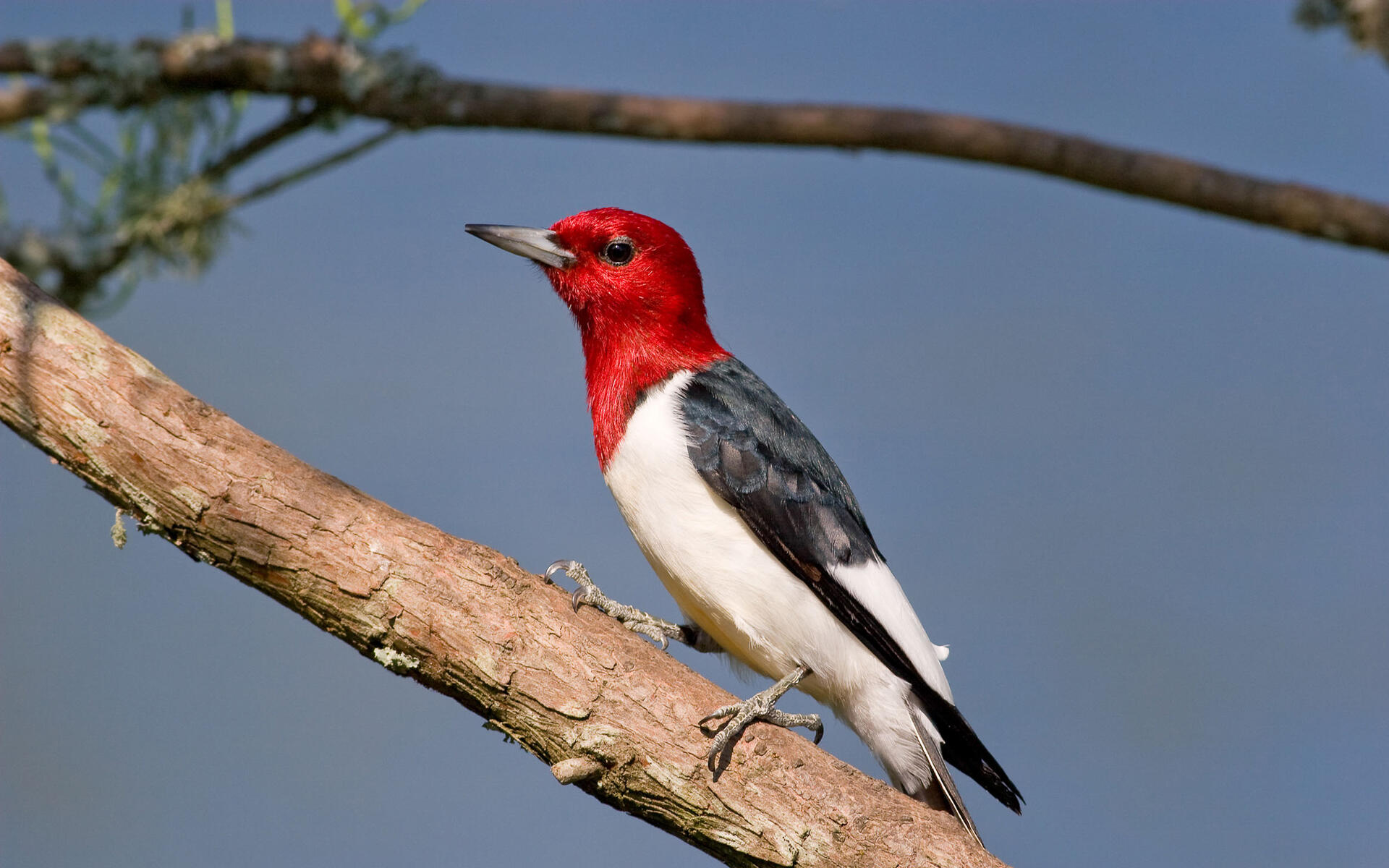 | Red-headed Woodpecker |
 | Pileated Woodpecker |
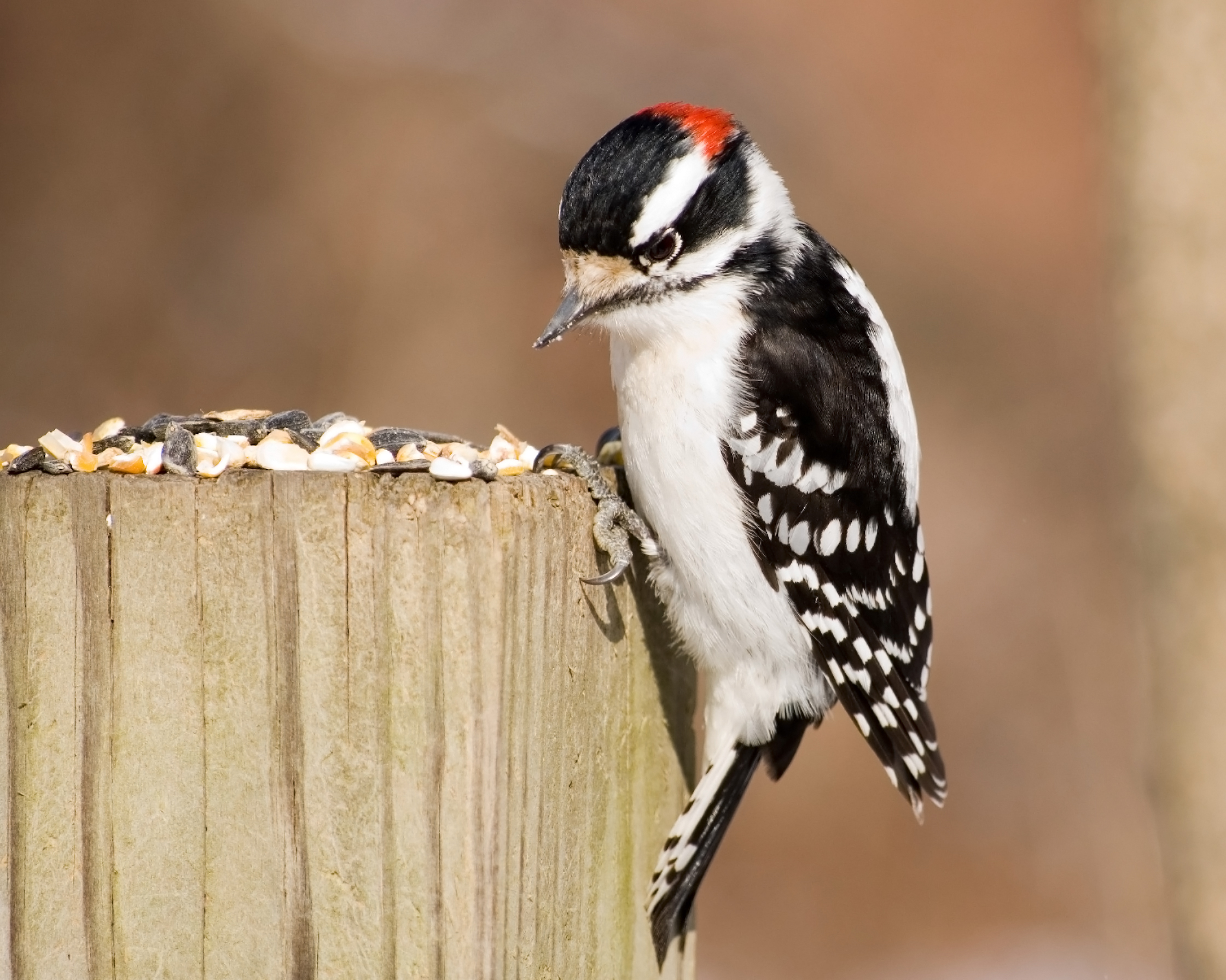 | Downy Woodpecker |
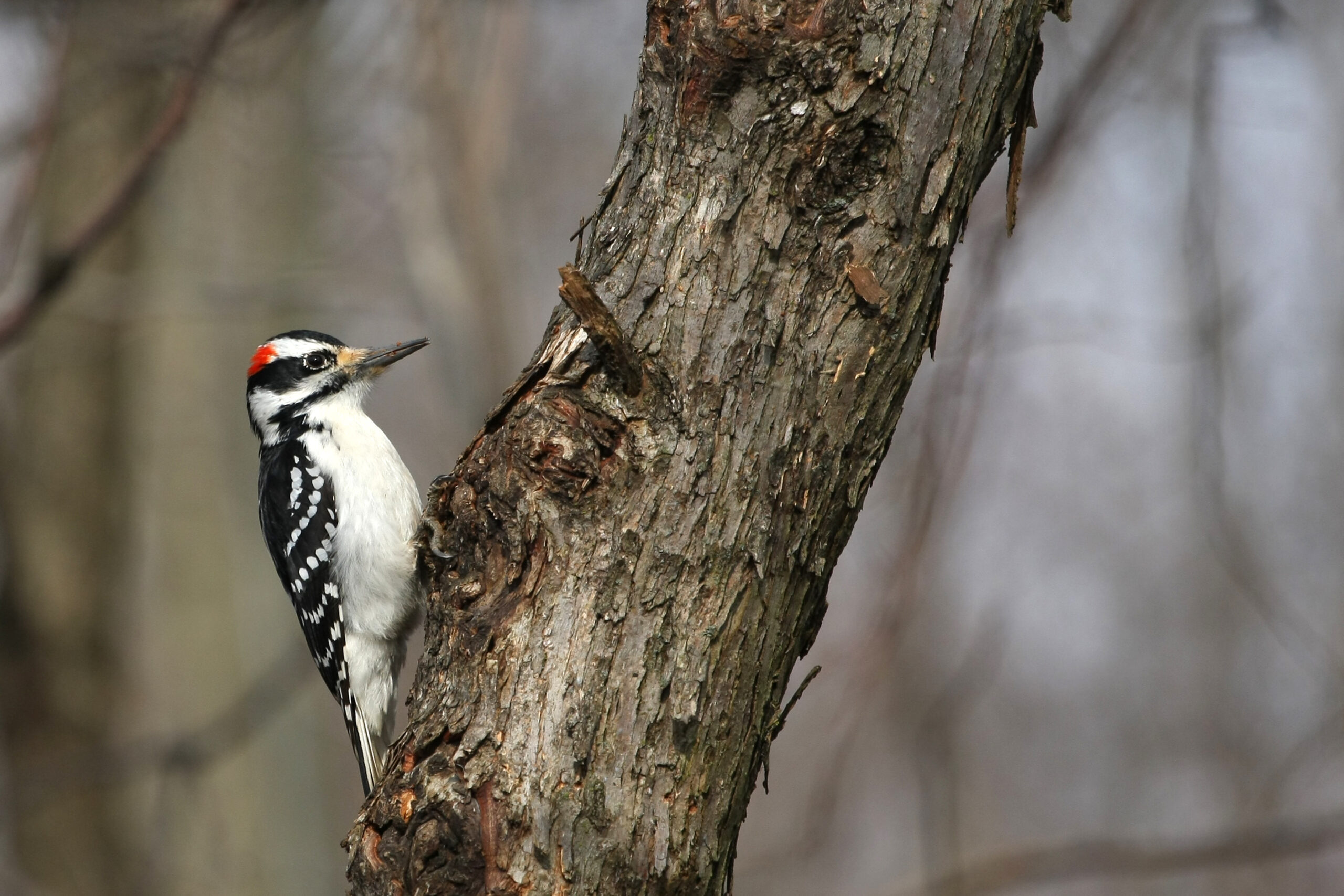 | Hairy Woodpecker |
 | Northern Flicker |
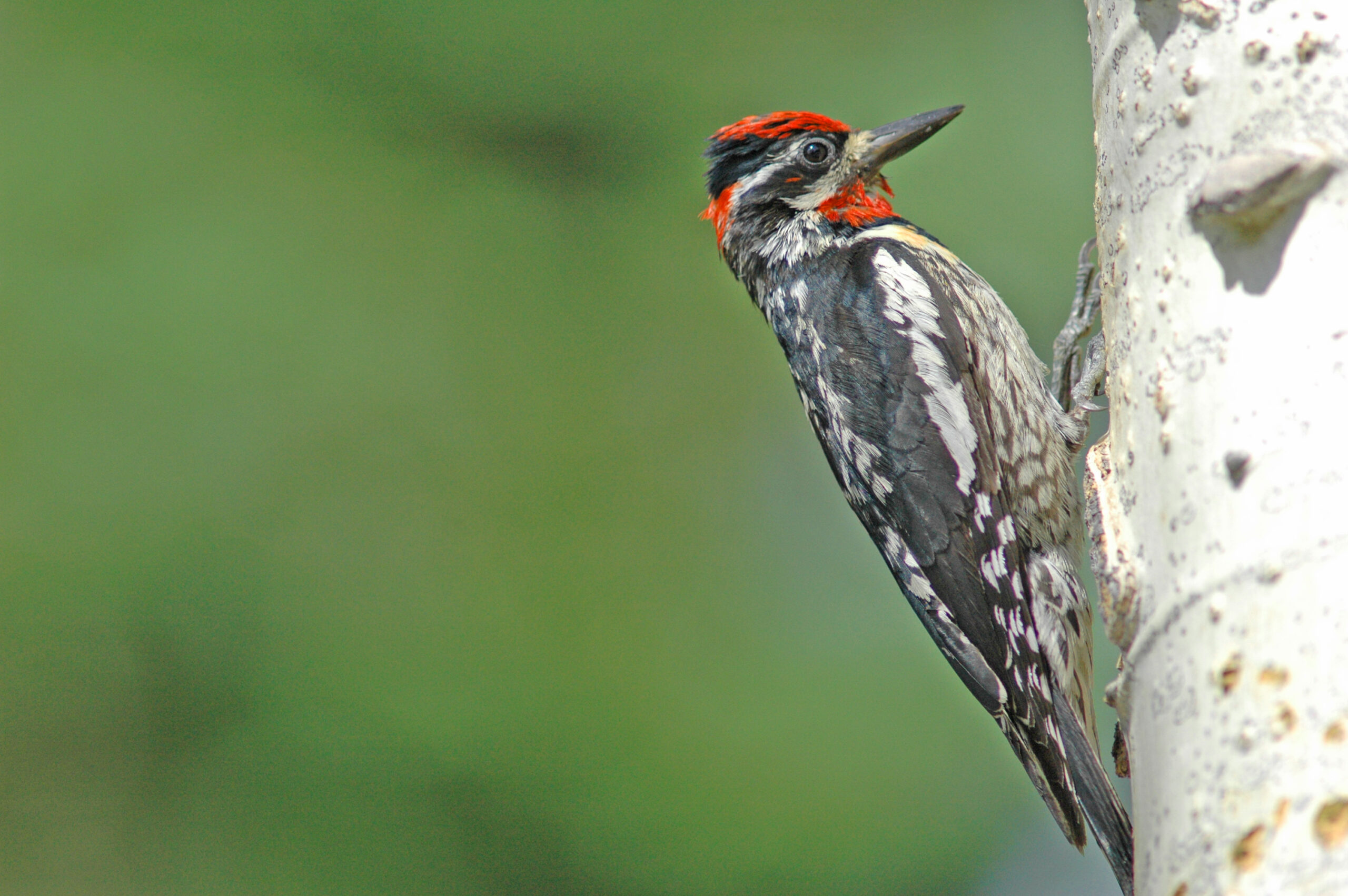 | Yellow-bellied Sapsucker |
Types of Woodpeckers in Iowa
1. Red-bellied Woodpecker
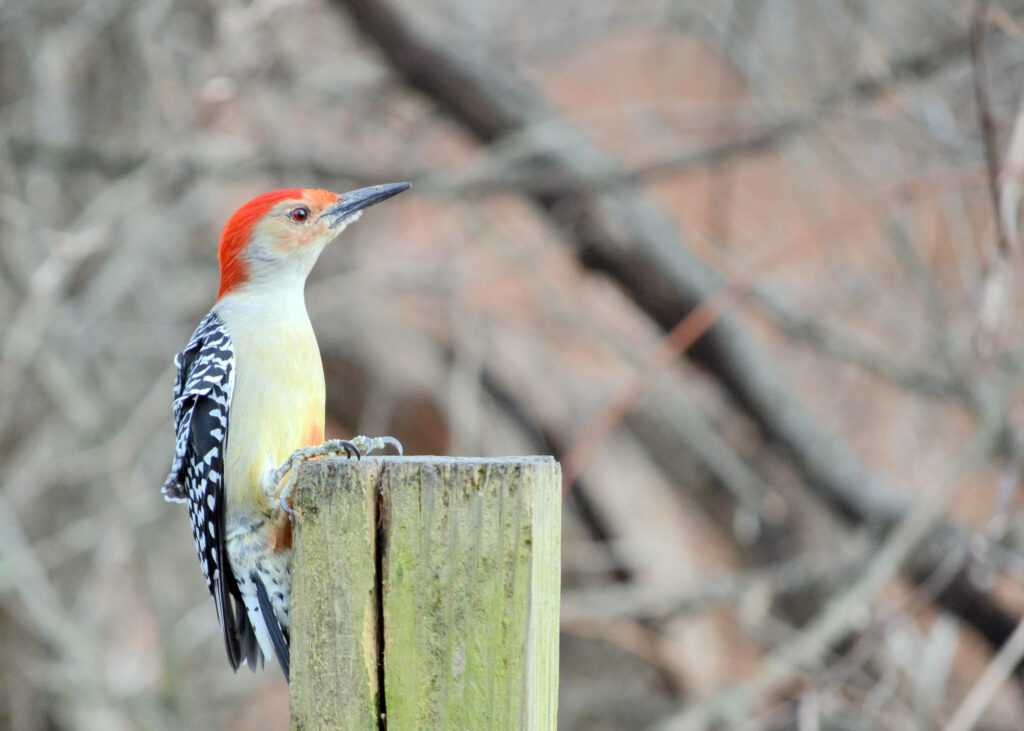
The tiny to medium-sized red-bellied woodpecker has white and black feathers on its body. The female does have a brownish crown, whereas the mature male seems to have a red one.
The crimson coloring on the bird’s lower abdomen, which is noticeable when it is in flight, gave rise to its nickname. In Iowa, you may find red-bellied woodpeckers in forested regions.
The red-bellied woodpecker digs its own crevice for its nest inside a tree since it is a cave nester. The bird might even build its nest inside man-made buildings like birdhouses.
The red-bellied woodpecker lives all year long across Iowa and is frequently spotted consuming fruits, nuts, and insects.
The bird is known as the “giggling chicken” because of its loud, laugh-like call.
| Scientific name | Melanerpes carolinus |
| Size | 9.3 to 9.6 inches |
| Wingspan | 13.2 to 16.6 inches |
| Weight | 2.1 to 3.3 ounces |
Food
You might be ready to get a red-bellied woodpecker toward a suet feeder if you spot one in your backyard. Mostly in winter, woodpeckers are particularly drawn to suet, a high-fat bird diet.
Install a suet feeder close to an open part of your backyard in which the bird might even see it to draw red-bellied woodpeckers. To stop the transmission of infections, remember to clean the suet feeder often.
In Iowa, the red-bellied woodpecker is indeed a ubiquitous bird that inhabits a wide range of habitats.
The red-bellied woodpecker is a delightful bird to observe and listen to in your garden because of its eye-catching coloration and booming cry.
2. Red-headed Woodpecker
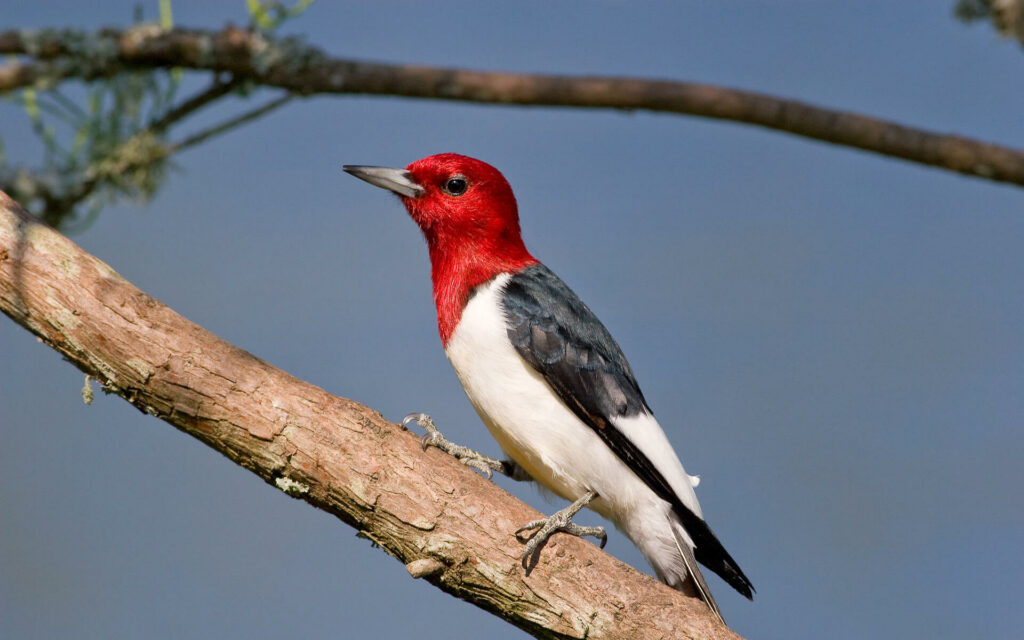
The red-headed woodpecker is really an attractive and distinctive bird. The female has quite a grayish-brown forehead, whereas the male does have a brilliant red one.
Black bars may be seen on the tail and wings, including both sexes, which have white underparts.
Throughout North America, this species can be encountered among woodlands and at the borders of forests. They are the most frequently observed throughout Iowa’s eastern and southern regions.
| Scientific name | Melanerpes erythrocephalus |
| Size | 7.6 to 9.2 inches |
| Wingspan | 16.4 to 17.0 inches |
| Weight | 2.1 to 3.3 ounces |
The red-headed woodpecker is renowned for its acrobatic prowess. They frequently fly upward and downward on tree trunks or are spotted suspended upside down over tree limbs.
Food
These birds consume insects, fruits, and nuts. They grasp their prey by reaching far into cavities with their long tongues.
Be careful to spend time watching a red-headed woodpecker if you come across one in Iowa.
3. Pileated Woodpecker

The Pileated Woodpecker, with something like the size of 19 to 22 inches and a wingspan of approximately 31 inches, is the biggest woodpecker across North America.
They have quite a red crown on their forehead and are covered in white and red stripes across their necks and faces.
The loud, unique cry of Pileated Woodpeckers, which resembles “kuk kuk kuk kuk,” is well recognized.
All of North America’s forested regions are home to Pileated Woodpeckers. The southern and eastern regions of Iowa are where these woodpeckers are most frequently observed.
| Scientific name | Dryocopus pileatus |
| Size | 15 to 20 inches |
| Wingspan | 29 to 31 inches |
| Weight | 9.3 to 14.1 ounces |
Habitat & Food
Although they are more common throughout forest vegetation, Pileated Woodpeckers may also be spotted within mixed, coniferous, and urban gardens and backyards.
The highly active Pileated Woodpecker can frequently be spotted soaring between branches or ascending tree trunks in looking for food.
Insects make up the majority of their food, although they also like to consume berries, fruits, and nuts.
Pileated Woodpeckers are crucial in regulating insect populations and maintaining the health of rainforests.
4. Downy Woodpecker

Across North America, the Downy Woodpecker would be the tiniest species. The adult Downy measures between six and seven inches in length and has a ten to eleven inches wingspan.
Short, straight, and black describe the beaks. The head features white cheeks, a black neck, and a black cap that reaches just beneath the tail.
The tail appears black having white outer plumage, the back comprises black feathers having white patches, and the wings appear black with white bars.
Most of the underparts remain white. Even though the male frequently has a red patch upon the backside of the forehead, both sexes are very similar.
All over North America, woods and grasslands are home to the Downy Woodpecker. It is unable to migrate, making Iowa its forever home.
Although it may also be observed among orchards and coniferous trees, the Downy would be most frequently observed on deciduous trees.
| Scientific name | Dryobates pubescens |
| Size | 6.9 to 7.2 inches long |
| Wingspan | 11 to 13 inches |
| Weight | 0.76 to 0.98 ounces |
It consumes berries, nuts, grubs, and spiders as food. The Downy Woodpecker digs its own hole for its own nest inside a tree. The male and female work together to build the nest and care for the offspring.
A little white and black woodpecker, little downy species widespread in the forests of Iowa. It features a black crown that hangs just beneath the neck and a thin, straight beak.
The mature Downy measures between six and seven inches long and has a ten to eleven-inch wingspan.
All over North America, woods and meadows are home to the Downy Woodpecker. It does not migrate, making Iowa it is a permanent home.
5. Hairy Woodpecker
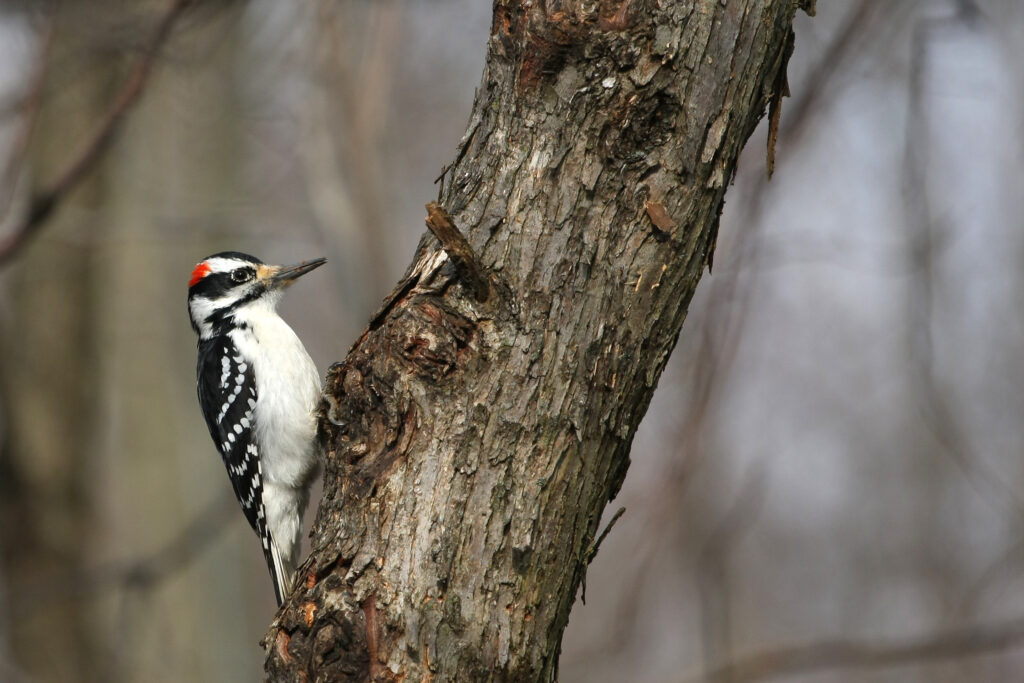
A medium-sized woodpecker that features black and white stripes all over its back and wings, the Hairy Woodpeckers.
The face appears white, having a black line running across the eye, and the skull does have a red cap. Adults have a wingspan of 28 centimeters (11 inches) and a length of around 16 centimeters (63 inches). Weight range: 50 to 70 grams (about 2 ounces).
All across North America’s forests are home to the Hairy Woodpecker. The northern and eastern regions of Iowa are where these woodpeckers are most prevalent. Because it is a permanent residents, they don’t migrate.
| Scientific name | Picoides villosus |
| Size | 7.4 to 7.6 inches |
| Wingspan | 12 to 17 inches |
| Weight | 1.3 to 3.5 ounces |
Carpenter ants, in particular, are a favorite food of the Hairy Woodpecker. Acorns, berries, and other nuts are also on its menu.
The Hairy Woodpecker creates a hole for its nest all by itself on a branch or decaying tree. The nest is dug by both the male and female.
The entryway aperture is typically 4 centimeters (1 and a half inches) broad, and the nest is typically approximately 30 centimeters (12 inches) deeper.
Between four and seven eggs are laid inside the nest by the female. The eggs are incubated by both parents and hatch after approximately two weeks. After around four weeks, the baby birds depart the nest.
6. Northern Flicker

The group of woodpeckers includes the Northern Flicker. It is the sole woodpecker throughout North America, having a red chest.
The male’s face is marked by a black mustache. Both sexes do have white rear and a brown back featuring black bands.
The wings have black stripes and are brown in color. The sides of the white underparts have black bands. The beak has a little curvature and is black. Gray defines the feet and the legs.
The Northern Flicker has a wingspan of around 22 inches and measures approximately 13 inches in length. It has a 4-ounce weight.
| Scientific name | Colaptes auratus |
| Size | 12 to 13 inches |
| Wingspan | 17.0 to 20.1 inches |
| Weight | 4.2 to 6.7 ounces |
Habitat & Food
Throughout North America, open forests, parkland, and yards are home to the Northern Flicker. It consumes seeds, berries, and insects for food. Additionally, it will consume suet from bird stations.
The Northern Flicker builds its nest in cavities. It drills a nest cavity in a stump or tree. Six to eight eggs are laid inside the nest by the female.
The eggs are incubated by both parents for roughly two weeks. Approximately three weeks after hatching, the youngsters fledge.
In Iowa, the Northern Flicker lives there all year long. In the morning and the evening, it is particularly active. It may group into small flocks and roost in trees throughout the winter.
7. Yellow-bellied Sapsucker

A medium-sized woodpecker possesses a yellow belly and black back, wings, and tail. The forehead, nape, and neck of the head are all white.
The chest has a yellow ribbon running across it. The male adult has a crimson crown. Although females and immatures lack the red crest, they are indistinguishable.
To eat insects and tree sap, this bird drills cavities in the trees. It frequently makes daily trips back to the exact same tree.
The Yellow-bellied Sapsucker builds its nest within a hole hewn out of a dead tree or snag. The approximately two-inch broad nest hole is dug by both sexes.
Four to five eggs are hatched by the female, and they are incubated for two weeks. The youngsters, who depart the nests after approximately three weeks, are fed with assistance from both parents.
The majority of North America, eastern of the Mountain Range, is covered in forests where you may find the Yellow-bellied Sapsucker. It often breeds in Iowa’s northern and eastern counties.
| Scientific name | Sphyrapicus varius |
| Size | 7.2 to 8.7 inches |
| Wingspan | 13.5 to 15.9 inches |
| Weight | 1.6 to 1.8 ounces |
This bird frequently spends the winter throughout southern regions or beside the sea. In Iowa, the Yellow-bellied Sapsucker is now a relatively common bird, however recent times have seen a drop in its population.
As trees are taken down for construction or farming, sufficient habitat is probably lost, which is the common explanation for this drop.
The mating season, which runs from April through July, is when you may witness Yellow-bellied Sapsuckers in Iowa at their most active. The birds might be spotted more frequently during this season in wooded areas close to rivers or streams.
Watch for when they drill a tree hole or even fly in a characteristic rippling pattern between trees.
They might also be pounding loudly, making a machine gun-like noise. Whether you’re lucky, you could get a glimpse of a Yellow-bellied Sapsucker on one of its preferred trees, eating on invertebrates or nectar.
Try erecting a nesting box made for woodpeckers to entice these birds to your backyard.
Suet and fruit are other options for artificial food sources. You may aid the recovery of the decreasing Yellow-bellied Sapsucker subspecies throughout Iowa by supplying both food and habitat.
Check out this article on the Types of Hawks in Iowa.
Conclusion
In all, there are 22 different species of woodpecker in the US. A third of these comprise the seven species of woodpeckers found throughout Iowa, which is rather remarkable.
There’s a decent possibility that if you reside around Iowa, you’ll see one of the stunning woodpecker species that make Hawkeye State home.
You could come across a few of these beauties sneaking peeks wherever you reside, whether it’s down by a riverside, in an empty area, or next to some woods.
FAQ
What kind of woodpecker is the biggest in Iowa?
Throughout Iowa, the Northern Flicker seems to be the biggest woodpecker. It lives across Iowa throughout the entire year and is still active mostly in the morning and at night. This might group into small flocks and perch in trees throughout the winter.
How can I get woodpeckers to visit my backyard?
Offering shelter and food to woodpeckers is the best effective technique to get them to your property. Suet or fruit can be used as an inorganic source of food, or you might erect a nest box made specifically for woodpeckers.
Last Updated on March 22, 2023 by Lily Aldrin
